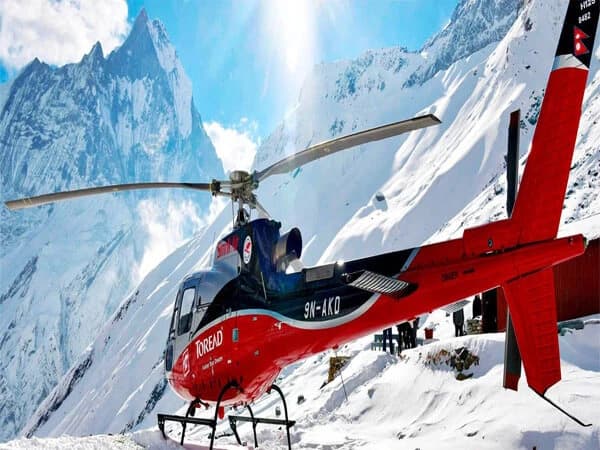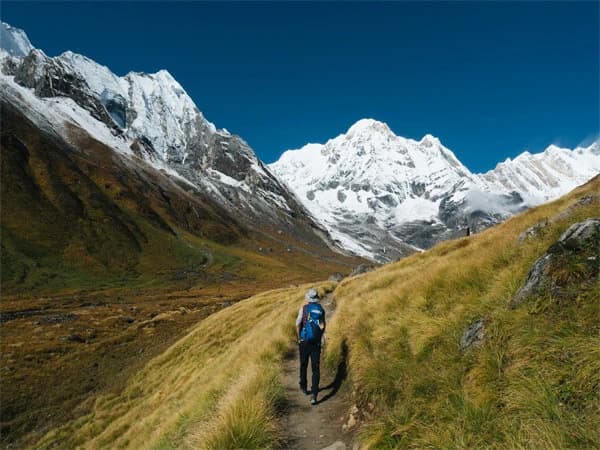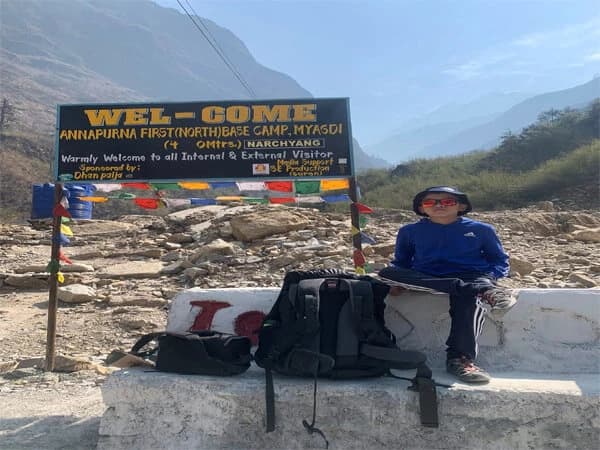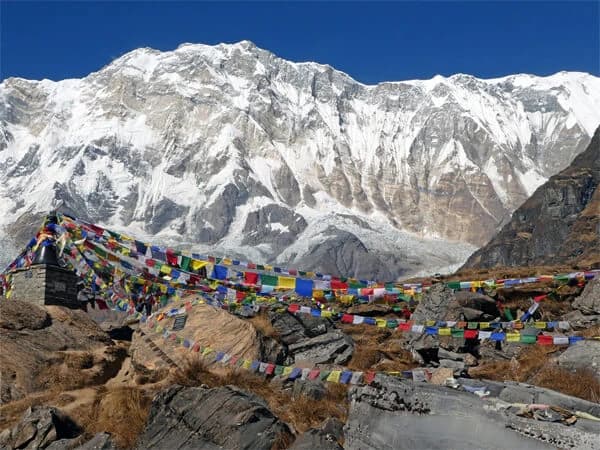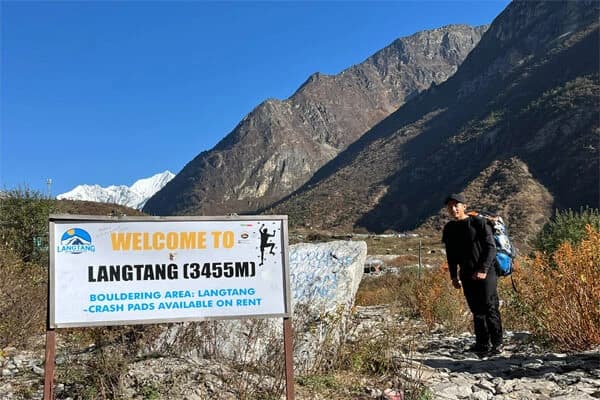I had been thinking about going to Annapurna Base Camp for years. I had read tourist blogs, watched videos of trekkers standing beneath the majestic peaks, and seen images of the snow-capped Alps. I was drawn to that location not only because I adore mountains but also because I'm seeking adventure, tranquility, and a little challenge.
Nepal has long been charmed by mystery. I wanted something unique, even though I knew it was well-known for Mount Everest. Something powerful yet less chaotic. I learned more about the Annapurna region at that point. It was full of rivers, stone cottages, forests, and happy smiles, and people said it was magical. Additionally, the Annapurna Base Camp (ABC) trek could be finished in 10–15 days, which was ideal for my timetable.
I wanted the whole experience, not just a trek. One where, after a long day of walking, I could meet locals, eat warm dal bhat, feel a connection to the country, and sleep under the stars. All of it and more was promised by Annapurna Base Camp.
The variety was another factor in my decision to do this trek. You travel through farming communities, up stone stairs, through rhododendron-filled woodlands, and eventually arrive at the open, snowy valley encircled by Himalayan giants. The tenth-highest mountain in the world, Annapurna I, is situated in the center of it all.
I made the decision that this was it. I started to dream about the days ahead after making my trek reservation with Nepal Trekking Routes, a local business that assisted me with all the preparations.
Travelling to Nepal for Annapurna base camp

My excitement increased upon my arrival in Nepal's capital, Kathmandu. The streets were vibrant, bustling, and alive. I spent a few days there to recuperate, tour the temples, and prepare my last equipment. After that, I took a plane to Pokhara, which is the entrance to the Annapurna region and a serene lakeside city.
Pokhara was stunning. On clear days, the white tips of the Annapurna range could be seen sparkling in the distance, the lake reflected the sky, and the mornings were serene. My heart raced just looking at the view. I was aware of my approach.
Getting Ready for the Annapurna Trek
Prior to the trek, I needed to make a few important arrangements:
- Annapurna Base Camp Trekking Permits: I required both a Trekkers' Information Management System (TIMS) card and an Annapurna Conservation Area Permit (ACAP). Fortunately, Nepal Trekking Routes made these arrangements for me.
- Check of my equipment: I had a sleeping bag, trekking boots, warm clothes, and a backpack already. Nevertheless, it was simple and reasonably priced for me to hire a few things in Pokhara, such as trekking poles and a down jacket.
- Meeting my guide: The night before our trip, I had a meeting with my guide. He was well-informed, amiable, and had completed the ABC route numerous times. I felt excited and safe when I spoke with him.
I double-checked my necessities, filled my water bottles, and packed my belongings that evening. Not because I was anxious, but rather because I was excited to get started, I had trouble sleeping. I had been fantasizing and planning for months, and now I was actually going to walk the Annapurna Base Camp trek.
We drove a short distance to the trek's beginning the following morning. I grinned as I peered out the window as we started to ascend into the hills after leaving Pokhara behind. I had no idea how much the journey would change me, but it had finally started.
The First Steps: From Pokhara to the Trailhead
Pokhara, a stunning lakeside city where the majority of Annapurna trekkers begin their trip, is where my trek started. I was both excited and a little anxious in the clear, chilly morning air. I had a brief breakfast before meeting my porter and guide. We loaded up a jeep with our backpacks and headed for the trailhead.
The Bumpy Ride to Nayapul or Ghandruk
We drove past green meadows, tiny villages, and twisting mountain roads. You can begin the trek from Ghandruk, Kimche, or Nayapul, depending on your itinerary. For me, we began at Ghandruk, a classic Gurung community situated atop a hill. Although the final stretch was somewhat bumpy and the travel took roughly four to five hours, the vistas were already breathtaking.
First Steps on the Trail
We had lunch in a tiny teahouse after we got there, where we could see Machapuchare (Fishtail Mountain) through the clouds. After that, we began to walk. Finally being on foot, taking in the fresh air, and listening to the sound of the river and birds was such a pleasant experience. At first, the walk seemed easy, winding through forests and up stone-paved stairs. I saw schoolchildren, other trekkers beginning their route, and residents carrying things.
Climbing Through Forests and Villages
Walking over the following days was like stepping into a postcard. We went by lovely terraced fields with crops being planted by farmers. Along steep hillsides were villages like Chhomrong, Sinuwa, and Bamboo, where we were greeted by cheerful people and stone homes.
Every community had a unique charm. With bakeries and views of Annapurna South, Chhomrong was a bustling place. I recall enjoying a piece of apple pie—yes, pie in the mountains at sunset. We stayed in comfortable teahouses at each destination; the dal bhat (rice and lentils) was usually satisfying, and the accommodations were basic but warm.
Repeatedly climbing up and down
I learned during this journey that in Nepal, It is common to descend before ascending. We would climb again after crossing suspension bridges and descending steep stone steps each day. Even though my legs hurt, I continued because of the shifting landscape. We stopped in tiny tea booths with hot ginger tea, strolled alongside roaring rivers, and passed stunning waterfalls.
Climbing the endless stairs from Chhomrong to Sinuwa was one day that will never be forgotten. Even though it was difficult, I persisted in moving slowly and methodically. "The locals say, “Bistari, bistari” (slowly, slowly), and that became my walking mantra."
Into the Rhododendron Forests
The scenery changed as we ascended higher. We moved into dense rhododendron forests, where trees were covered in moss and distant birds could be heard calling. The experience was similar to traveling a mystical green tunnel. In the mornings and evenings, I had to wear a light jacket because the air was colder.
With the forest all around, the town of Bamboo felt serene and tranquil. After a long day, it was the ideal spot to relax. I fell asleep to the murmur of the Modi River.
The Trail and the People
Meeting new individuals along the route was one of the trek's highlights. At night, fellow trekkers share stories, locals carry firewood, and happy kids wave "Namaste." We all felt united by the same journey, despite the fact that we were from various nations. The Annapurna trek was about more than simply the mountains; it was also about the people, the natural rhythm, and the everyday delight of walking.
Getting to the Higher Trails
Climbing above the Forest Line
I finally arrived at the alpine zone after several days of trekking through woods, stone steps, and verdant landscapes. The scenery became stony and open, the air felt colder, and there were fewer trees. The trail became calmer after Deurali. There are fewer settlements and people, but there is also more quiet with snow-capped mountains in the background.
It was an thrilling and difficult walk from Deurali to Machapuchare Base Camp (MBC). The trail rose gradually, but I started to feel the effects of the altitude. It took more work at each phase. I walked gently while paying attention to my breath and drinking a lot of water. I noticed tiny avalanches dropping in the distance along the route; they were lovely but strong.
Arriving at Machapuchare Base Camp

Upon arriving at Machhapuchare Base Camp, which is around 3,700 meters, I was both exhausted and pleased. The vista of Machapuchare, popularly referred to as "Fishtail Mountain," was stunning. It appeared to be a guardian keeping watch over us from its pointed, holy summit. In order to recover and be ready for the final push to Annapurna Base Camp (ABC) the following morning, I spent the night here. It was freezing that night. I put on all of my warm clothing, including gloves and a hat. Above, the stars were bright and clear. Being in such a strong location made me feel little, but I was also thankful.
The Final Climb to Annapurna Base Camp
I went for a walk before the sun came up the following morning. The trek was lengthy and Annapurna Base Camp elevation high, but it wasn't particularly difficult. With snow and mountains all about, I took deep breaths and walked gently. The world was silent.
I eventually reached Annapurna Base Camp (4,130 meters) after roughly two hours. Massive peaks known as Annapurna I, Annapurna South, Hiunchuli, and Gangapurna encircled me on all sides. It felt as though you were standing in the center of a massive mountain bowl.
Sunrise at Annapurna Base Camp
Getting Up Before the Sun
I got up earlier than five in the morning. I was too delighted to stay in bed, even though it was extremely cold. After putting on all of my clothing, I went outside with a cup of hot tea and my camera. The silence lingered. The majority of trekkers were waiting silently outside as well.
Gradually, the sky turned from dark to blue to pink. When the first rays of the sun struck the snowy peaks, which had been dark just a moment before, they began to shine gold.
Seeing the Mountains Awaken
It was a breathtaking sunrise over the world's tenth-highest peak, Annapurna I. Like a gentle blanket, the golden light flowed down the mountainside. Everything was ideal for a brief while still, quiet, and serene.
I was just standing there with tears in my eyes. It was the feeling of arriving at the destination after walking for days, not only the beauty. The difficult steps, chilly evenings, and aching legs were all worthwhile. I felt thankful, alive, and incredibly bonded to the natural world.
Reflective Moments
As I stood at Annapurna Base Camp, I reflected on all that I had witnessed on my journey: mountain goats, warm locals, happy kids, other trekkers from all over the world, frozen waterfalls, and countless stone steps. This was the end of it all. Though they can't talk, the mountains can teach. They remind you to be little, modest, and awe-inspiring. I inhaled deeply and made an effort to process everything.
The Return Trek: A Different Perspective
Coming Down Felt Lighter—But Not Easier
It was time to leave Annapurna Base Camp after the breathtaking sunrise. Since the walk back was primarily downhill, I thought it would be simple. However, I was mistaken. Yes, it was physically less exhausting than climbing, but by this point, I had less energy, my legs hurt, and my knees hurt with each step. Even so, I felt emotionally lighter. I had completed the task. I arrived at the base camp. I was able to endure the long days of walking back because of that sense of accomplishment.
Observing Things I Had missed earlier
I was concentrated on getting to the top as I ascended. I had more time to appreciate the small things on the way down, such the peaceful streams, the colorful prayer flags, the ancient stone steps, and the happy villagers. The same villages Deurali, Bamboo, and Sinuwa passed by, but this time I was genuinely struck by their appeal. I even recognized some of the familiar people from before. I had the impression that I was on familiar territory.
A Growing Sense of Gratitude
I was grateful for my body, the mountains, and the good people I encountered as I made my way through the woods and across the rivers. Every stride seemed like a silent farewell to the Himalayas. I was aware that I would miss the challenge as well as the cool air and serene paths. The journey back turned into a period of introspection. I had time to reflect on what I had witnessed and discovered.
Challenges I Faced and What I Learned
Dealing with Physical Struggles
The most significant obstacle was physical discomfort. We walked for 6-7 hours straight on some days. The steps, both up and down, were endless, my legs were burning, and my shoulders ached from carrying a daypack. At higher elevations, I immediately became out of breath. The nighttime cold was particularly severe at ABC and Machapuchare Base Camp, when it fell below freezing. It was still chilly even after I put on all of my warm clothing.
Overcoming Mental Battles
Even more difficult than the physical portion was the mental one. I had times when I wanted to stop. Sometimes I would wake up exhausted and ask myself, "Is it possible for me to repeat this today?" But I continued. I told myself that I should do one step at a time. I discovered how to be patient, pay attention to my body, and maintain my composure. That small change in perspective got me through the difficult times.
The Importance of a Good Support System
I was lucky to trek with kind guide and porter from Nepal Trekking Routes. They were patient, informed, and friendly. They made sure I ate well, told me stories about the area, and cheered me up when I was exhausted. The entire trip was more pleasurable and went more smoothly when there were folks who knew the mountains. I discovered that a little help goes a long way and that you don't have to do everything by yourself.
Lessons That Stay With Me
This journey was more than just a walk to the foot of a mountain; it was a discovery of my own abilities. Even when it didn't seem like I had enough strength, I discovered how to trust it. I witnessed how nature can calm you down, heal you, and teach you the important things. I also came to see how crucial it is to be emotionally and physically ready.
Above all, I learned the value of simplicity a steaming cup of tea, a comforting meal after a long day, a warm smile, and an awe-inspiring vista.
Tips for Future Trekkers
Choose the Right Season for Annapurna Base Camp Trekking
Spring (March to May) and fall (September to November) are the ideal seasons for trekking to Annapurna Base Camp. The weather is clear, the skies are beautiful, and the vistas of the mountains are breathtaking throughout these months. Steer clear of the monsoon season (June to August) as the trails get slick and the vistas may be obscured by clouds.
Physical Fitness for Annapurna Base Camp Trekking
ABC Trek requires a certain level of physical fitness even if It is not the most difficult trek in Nepal. A few weeks before to your excursion, begin walking or trekking on a regular basis. It is a fantastic idea to practice climbing stairs while carrying a backpack. It increases your stamina and adds enjoyment to the actual walk.
Pack Light But Smart
Keep only the essentials with you. Essentials include a raincoat, a headlamp, water bottles, a warm jacket, a decent set of trekking shoes, quick-drying clothing, and some snacks. Layering is essential because the weather changes quickly. Because the sun is strong at high altitudes, remember to pack a hat and sunscreen.
Go With Trusted Local Trekking Company
Safety and local knowledge are guaranteed while trekking with a local organization like Nepal Trekking Routes. You can experience the culture, change your pace, and stay on course with the help of a good guide. Additionally, it boosts the local economy.
Pay Attention to Your Health
Don't push yourself too hard, take breaks, and stay hydrated. Everyone is impacted by altitude, so take it leisurely and savor the ride. The secret is to take your time.
Annapurna Trekking Cost

I wanted to manage my money carefully. I wanted to feel secure, at ease, and cared for during the trip, but I wasn't searching for a luxurious experience. All in all, the price was fair and well worth it.
Depending on my preferences, the total cost of this journey ranged from $1,200 to $1,600 USD. My local trekking company, Nepal Trekking Routes, helped me organize everything in on package, including permits, lodging, food, a guide, and a porter. Making a reservation with a local business provided me piece of mind in addition to financial savings.
Once the trek began, I didn't have to worry about many things because flights, permits, and daily meals were already taken care of. I did have some spare cash on hand for Wi-Fi, hot showers, snacks, and gratuities for the porter and guide. The price seemed quite reasonable in comparison to what I had experienced, which included stunning mountain vistas, friendly local people, and the excitement of arriving at Annapurna Base Camp.
I would advise making reservations in advance, traveling with knowledgeable locals, and packing a bit extra for comfort if you want to undertake the same adventure. Although trekking in the Himalayas isn't free, It is well worth the money for the peace, difficulty, and life-changing experiences it offers.
Some of Frequently Asked Question
How difficult was the Annapurna Base Camp (ABC) trek?
The Annapurna base camp trek difficulty is considered as moderate trekking in Nepal. Being physically active is crucial, but you don't have to be an expert trekker. Particularly close to Chhomrong and Sinuwa, there were a lot of stone steps, steep ascents, and long walking days. Dealing with the cold and altitude close to the base camp was the most difficult aspect. However, relaxing, drinking water, and moving slowly were quite beneficial.
How many days did the Annapurna Base Camp trek take?
My 10-day journey began in Tikhedhunga and ended in Nayapul. If they include Poon Hill or go more slowly, some people take 10–12 days. Depending on your schedule, most treks to ABC run between 7-10 days, while there are other route possibilities.
Did I require a porter or guide for Annapurna Base Camp Trek?
Yes, I used Nepal Trekking Routes to hire a guide, and it really simplified my journey. Finding good teahouses, obtaining licenses, and navigating were all made easier by the guide. Although I didn't employ a porter, having someone to carry the bulky backpack would have been useful, particularly on steep ascents.
What part of the journey did you like the most?
The sunrise at Annapurna Base Camp was the highlight. It was enchanting to see the snow-covered summits bathed in golden light. The journey was also made remarkable by encountering friendly locals in mountain communities, crossing rivers, and strolling through rhododendron forests.
What should I pack for this trek?
Bring a sleeping bag, water bottles, snacks, rain gear, warm clothing, and a decent set of trekking shoes. Particularly at higher elevations, the weather is subject to sudden fluctuations. I also found that a hat, trekking poles, and a headlamp were quite helpful.
What is Annapurna Base Camp elevation?
Annapurna Base Camp (ABC) is situated at an elevation of roughly 13,550 feet (4,130 meters) above sea level. Encircled by majestic Himalayan peaks such as Hiunchuli, Machapuchare, and Annapurna I (8,091 m), it is located in the center of the Annapurna Sanctuary. Despite being a high-altitude walk, most trekkers with a basic level of fitness can complete it due to the well-marked track and moderate elevation.
Conclusion: Trekking to Annapurna Base Camp in Nepal
I was transformed by the experience of trekking to Annapurna Base Camp in Nepal. It was more than just a mountain walk. I learned something new at every turn on the trail. I discovered how to take deep breaths, slow down, and appreciate the beauty all around me. I felt calm and liberated by the quiet existence in the mountains no hustle, no noise, just nature and good people.
I felt little, but in a nice way, as I arrived at the base camp and stood beneath the enormous peaks. It served as a reminder of the beauty and might of nature. In addition, I was proud of myself for completing the difficult walk.
I will always cherish the memories I made on my adventure. The Annapurna Base Camp trip is among the best things you can do in Nepal if you enjoy the outdoors and desire an experience that will change your life.





